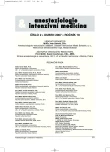Prospectives of antimicrobial therapy in the near and far future
Authors:
M. Kolář 1; A. Jedličková 2
Authors‘ workplace:
Klinika anesteziologie, resuscitace a intenzivní medicíny, VFN Praha
1; Ústav klinické biochemie a diagnostických laboratoří, Klinická mikrobiologie a antibiotické centrum , VFN Praha
2
Published in:
Anest. intenziv. Med., 18, 2007, č. 2, s. 103-112
Category:
Intensive Medicine - Comprehensive Article
Overview
At present the most important problem of antimicrobial therapy is acquired resistance in every category of micro-organisms. The solution to this problem lies in research of new antimicrobial therapeutics (antibiotics) in the groups of drugs used for a long time and research into new groups. An important inspiration for this undertaking comes from basic research of plants mainly from tropical forests and human antimicrobial agents (cathelicidines, defensines). However, this approach does not suffice due to the rapid development of resistance of the micro-organisms and therefore the shortening lifespan of new antibiotics. Other options are considered e.g. bacteriophage therapy, the use of extracorporeal elimination for the killing of the microbes and others. Many of these methods were successfully implemented in experiments. In the near future (10–20 years ahead) we expect multiresistance of gram-negative bacterial strains to be the main problem, as we do not possess new antibiotics for clinical use and/or advanced research. Fungal infections may become a greater problem than nowadays. Nevertheless, we predict that antibiotic therapy will remain the most important therapeutic method in the treatment of infectious diseases. Alternative therapeutic approaches may play a more significant role in the treatment in the more distant future.
Key words:
new antibiotics – microbial resistance
Labels
Anaesthesiology, Resuscitation and Inten Intensive Care MedicineArticle was published in
Anaesthesiology and Intensive Care Medicine

2007 Issue 2
Most read in this issue
- Oxygen toxicity in the course of hyperbaric oxygenotherapy
- Postintubation tracheal rupture – a case report
- Anaesthesiology and resuscitation in The Central Army Hospital in Prague (1948–1972)
- The benefits of BIS monitoring during sevoflurane anaesthesia in children
